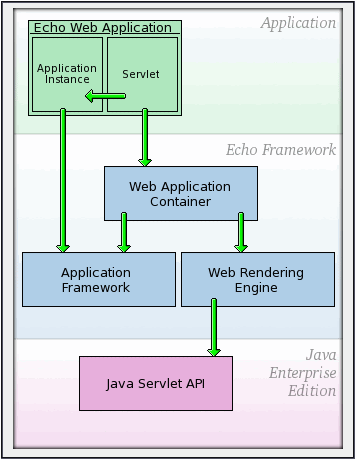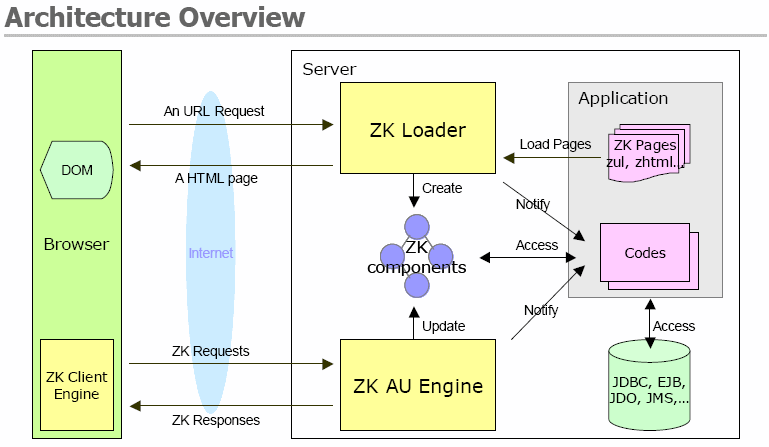What better place to learn something than go the source itself! I am posting some of the youtube videos related to AJAX and Google GWT and Gears
Better AJAX Apps:Gears, GWT, Dojo
This video provides some interesting information on integration of Google Gear with GWT and Dojo.
Building better AJAX aps with Google Gears
If you want to learn what Google Gears can do for you, watch the Google Gear launch event in London.
Are you looking for a lightweight database, checkout the SQLite. Google gear uses it for storing the offline data on client machine.
Last but not the least, watch the Google Mashup Showcase.
Sunday, June 24, 2007
Monday, June 18, 2007
GWT Vs Echo2
Echo2 is another AJAX framework, and it's similar to GWT in how it's used to create the UI. Echo2 has widgets to create the UI component similar to GWT. Though both framworks use similar APIs, they work very differently.
In Echo2 framwork, you compile your java source to java class files and run them on server. When a client-side event is triggered, it must be handled by server. The interface built with Echo2 needs to hit the server more often. The advantage of is that you don't have to deal with an RPC API because RPC happens all by itself. Echo2 doesn't need to send all the JavaScript to the browser at once. It sends only what is needed by the current state of the application.
In Echo2 framwork, you compile your java source to java class files and run them on server. When a client-side event is triggered, it must be handled by server. The interface built with Echo2 needs to hit the server more often. The advantage of is that you don't have to deal with an RPC API because RPC happens all by itself. Echo2 doesn't need to send all the JavaScript to the browser at once. It sends only what is needed by the current state of the application.
Sunday, June 17, 2007
HOW-TO: GWT Project Setup for Eclipse
I have created a step by step guide to creating a GWT project in Eclipse. Click on the link below to get to it
GWT Project Setup
Shaun wrote an excellent overview of GWT framework. Follow the link to his blog.
GWT Project Setup
Shaun wrote an excellent overview of GWT framework. Follow the link to his blog.
Monday, June 11, 2007
Echo2 Framework for AJAX
Echo2 is another server based AJAX framework. Similar to ZK, this works of the event driven model. The framework contains several built-in UI component ready to use for development. Custom components can be added to the framework via pure java programming.
The primary development environment for Echo is Java, which makes it much cleaner maintainable, and reusable. Using Echo2 studio (an eclipse plugin), you can quickly build an UI from existing components. The technology has been around for sometime, so it is quite mature.
 The Echo2 framework is divided into three distinct modules:
The Echo2 framework is divided into three distinct modules:
the Applocation Framework, the Web Rendering Engine, and the Web Application Container. The "Application Framework" provides an API to manage the state of an application and it's user interface. The Web Rendering Engine is consist of server and client. The server-side provides an HttpServlet to process requests from client-side. The client-side engine is a JavaScript application which runs in the client web browser and interacts with the server engine to provide remote user interface to the server-side application. The Web Application Container is an extention of the Web Rendering Engine that serves to render and synchronize the state of a user interface built with the Application Framework with remote web clients.
The primary development environment for Echo is Java, which makes it much cleaner maintainable, and reusable. Using Echo2 studio (an eclipse plugin), you can quickly build an UI from existing components. The technology has been around for sometime, so it is quite mature.
 The Echo2 framework is divided into three distinct modules:
The Echo2 framework is divided into three distinct modules:the Applocation Framework, the Web Rendering Engine, and the Web Application Container. The "Application Framework" provides an API to manage the state of an application and it's user interface. The Web Rendering Engine is consist of server and client. The server-side provides an HttpServlet to process requests from client-side. The client-side engine is a JavaScript application which runs in the client web browser and interacts with the server engine to provide remote user interface to the server-side application. The Web Application Container is an extention of the Web Rendering Engine that serves to render and synchronize the state of a user interface built with the Application Framework with remote web clients.
Sunday, June 10, 2007
Getting into the AJAX mode
I looked through some of the AJAX technologies and few of them caught my attention were ZK, GWT (Google Web Toolkit), and Echo2.
I downloaded the ZK demo examples. ZK is a server side AJAX-based engine which uses XUL (XML User Interface Language) and XHTML components to develop rich UI components. ZK also supports markup language ZUML (ZK User-interface Markup Languagae) to design user interfaces without programming.
ZK is purely a presentation tier solution, keeping the business tier and data tier intact. It can co-exist with existing technology like JSP and work seemlessly. It has ability to integrate with FCKeditor and JFreeChart in a very short amount of time.

It is #1 Active project on Sourceforge. It was worth exploring the capabilities.
I downloaded the ZK demo examples. ZK is a server side AJAX-based engine which uses XUL (XML User Interface Language) and XHTML components to develop rich UI components. ZK also supports markup language ZUML (ZK User-interface Markup Languagae) to design user interfaces without programming.
ZK is purely a presentation tier solution, keeping the business tier and data tier intact. It can co-exist with existing technology like JSP and work seemlessly. It has ability to integrate with FCKeditor and JFreeChart in a very short amount of time.

It is #1 Active project on Sourceforge. It was worth exploring the capabilities.
Subscribe to:
Posts (Atom)